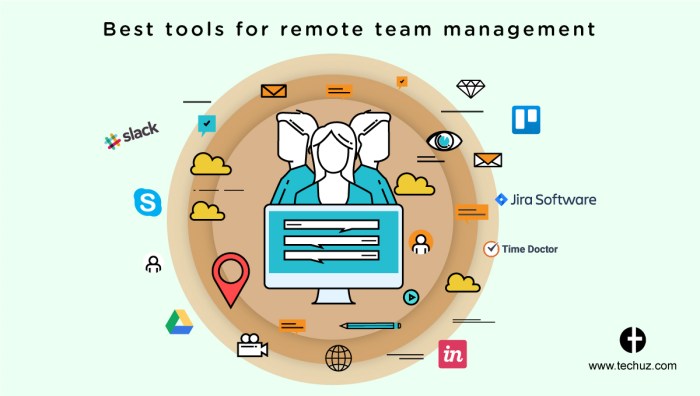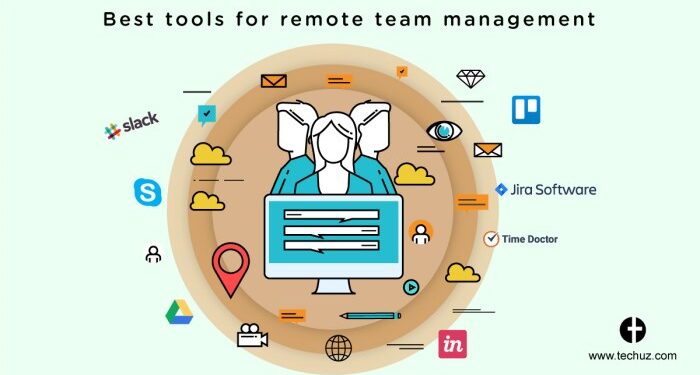Delving into the realm of innovative remote team collaboration tools, this introductory paragraph aims to provide a compelling overview of the topic, emphasizing the significance of these tools in the current work landscape.
It will also touch upon the key features that enhance remote team productivity and communication, setting the stage for a detailed exploration ahead.
Overview of Remote Team Collaboration Tools
In today's work environment, remote team collaboration tools have become essential for ensuring effective communication and productivity among teams working remotely.
Key Features of Remote Team Collaboration Tools
- Real-time messaging and chat functionalities for quick communication.
- File sharing and document collaboration capabilities to work on projects together.
- Task management tools to assign, track, and organize tasks among team members.
- Video conferencing and virtual meeting rooms for face-to-face interactions.
Benefits of Using Remote Team Collaboration Tools
- Improved team communication and coordination, leading to better project outcomes.
- Enhanced productivity as team members can collaborate efficiently regardless of physical locations.
- Increased flexibility and work-life balance for remote team members.
- Cost savings by reducing the need for physical office space and travel expenses.
Types of Innovative Remote Team Collaboration Tools
In today's digital age, there is a wide array of innovative remote team collaboration tools available to help teams work together seamlessly, regardless of their physical location. These tools are designed to enhance communication, streamline project management, and facilitate efficient file sharing among team members.
Project Management Tools
Project management tools are essential for remote teams to stay organized, track progress, and meet deadlines effectively. These tools offer features like task assignment, scheduling, and progress tracking. Popular examples include Trello, Asana, and Monday.com.
Communication Platforms
Communication platforms are crucial for remote teams to stay connected and collaborate in real-time. These tools enable instant messaging, video conferencing, and virtual meetings. Some widely used communication platforms include Slack, Microsoft Teams, and Zoom.
File Sharing and Storage Platforms
File sharing and storage platforms are necessary for remote teams to access and collaborate on documents, presentations, and other files. These tools allow team members to share, edit, and comment on files securely. Common examples of file sharing platforms are Google Drive, Dropbox, and OneDrive.
Collaboration Suites
Collaboration suites combine project management, communication, and file sharing features into one comprehensive platform. These tools offer a centralized hub for team collaboration, making it easier for team members to work together efficiently. Examples of collaboration suites include Microsoft 365, G Suite, and Zoho Workplace.
Features and Functionalities

Remote team collaboration tools should possess essential features to facilitate seamless communication among team members. These tools play a crucial role in ensuring productivity and efficiency in remote work settings. Integrations with other software can enhance the functionality of these tools, allowing for a more streamlined workflow.
Customizable options and scalability are also important factors to consider, as different teams may have varying needs and sizes.
Essential Features for Seamless Communication
- Real-time messaging and chat capabilities for quick communication.
- File sharing and collaboration tools for easy access to documents and resources.
- Video conferencing and virtual meeting rooms for face-to-face interactions.
- Task management and project tracking features to keep everyone aligned and on track.
- Integration with calendars and scheduling tools to coordinate meetings and deadlines efficiently.
Enhanced Functionality through Software Integrations
- Integration with project management tools like Trello or Asana for seamless workflow management.
- Connecting with customer relationship management (CRM) software to track client interactions and progress.
- Syncing with email platforms for unified communication across different channels.
- Compatibility with document editing software such as Google Docs or Microsoft Office for collaborative editing.
Customizable Options and Scalability
- Customizable user permissions to control access to sensitive information.
- Scalability to accommodate growing team sizes and evolving needs.
- Personalization options for team members to tailor the tool to their preferences.
- Adaptability to different work styles and preferences to enhance user experience.
Security and Data Privacy
In the realm of remote team collaboration tools, ensuring the security and privacy of data is paramount to maintaining trust and protecting sensitive information.Encryption plays a crucial role in safeguarding data shared through these tools. By converting data into a code that can only be accessed with the right decryption key, encryption helps prevent unauthorized access and interception of confidential information.Implementing strong authentication measures, such as two-factor authentication, can add an extra layer of security to verify the identity of users accessing the collaboration platform.Regularly updating software and systems, conducting security audits, and providing cybersecurity training to team members are essential best practices for maintaining a secure collaboration environment.
Best Practices for Secure Collaboration
- Use end-to-end encryption to protect data in transit and at rest.
- Implement access controls to ensure that only authorized users can view or modify sensitive information.
- Regularly monitor and audit user activity to detect any suspicious behavior or unauthorized access.
- Enable secure file sharing options that restrict downloads and limit access to specific team members.
- Choose collaboration tools from reputable providers with a strong track record of prioritizing security and data privacy.
Implementation Strategies
Implementing remote team collaboration tools successfully within an organization requires careful planning and execution. Here are some steps and tips to help ensure a smooth transition and maximize the benefits of these tools:
Onboarding Team Members
- Provide comprehensive training on how to use the tools effectively, including tutorials and hands-on practice sessions.
- Assign a dedicated person or team to support team members during the onboarding process and address any questions or concerns.
- Encourage open communication and feedback from team members to identify any issues early on and make necessary adjustments.
Ensuring Adoption of New Tools
- Highlight the benefits of using the tools and how they can improve productivity, collaboration, and communication within the team.
- Set clear expectations and goals for using the tools, and provide regular updates on their usage and impact.
- Reward and recognize team members who actively engage with the tools and showcase best practices to inspire others.
Training and Support
- Offer ongoing training sessions and resources to help team members continuously improve their skills and knowledge of the tools.
- Establish a help desk or support system where team members can reach out for assistance and troubleshooting.
- Create a community or forum where team members can share tips, tricks, and best practices for using the tools effectively.
Future Trends and Innovations
The landscape of remote team collaboration tools is constantly evolving, with emerging trends and innovations shaping the way teams work together. One of the key trends to watch out for is the integration of artificial intelligence (AI) in collaboration tools.
AI can enhance productivity by automating repetitive tasks, providing insights from data, and even improving communication within remote teams.
AI Integration in Remote Collaboration Tools
AI-powered features such as smart scheduling assistants, automated language translation, and intelligent task management are becoming more prevalent in remote team collaboration tools. These AI capabilities can streamline workflows, reduce manual errors, and ultimately boost efficiency in virtual team environments.
- Smart Scheduling Assistants: AI algorithms can analyze team members' schedules and preferences to suggest optimal meeting times, reducing the back-and-forth of scheduling.
- Automated Language Translation: AI-powered tools can translate messages and documents in real-time, breaking down language barriers in global teams.
- Intelligent Task Management: AI can prioritize tasks, assign deadlines, and even predict potential roadblocks to project completion, helping teams stay on track.
AI integration in remote collaboration tools is not just about automation but also about enhancing human capabilities and fostering seamless communication and collaboration.
Virtual Reality in Remote Collaboration
Another exciting trend on the horizon is the use of virtual reality (VR) technology in remote team collaboration. VR can create immersive virtual environments where team members can interact, brainstorm ideas, and work together as if they were in the same physical space, even if they are miles apart.
- Immersive Meetings: VR technology can simulate face-to-face meetings, complete with virtual conference rooms and interactive whiteboards, providing a more engaging and realistic collaboration experience.
- Virtual Team Building: VR platforms can host team-building activities, workshops, and social events, fostering a sense of camaraderie and connection among remote team members.
- Collaborative Design: Design teams can use VR to visualize projects in 3D, make real-time modifications, and gather feedback from colleagues, enhancing creativity and innovation.
Virtual reality has the potential to revolutionize remote team collaboration by bridging the gap between physical distance and creating shared virtual spaces for teams to work together seamlessly.
Final Summary
Wrapping up our discussion on innovative remote team collaboration tools, the concluding paragraph encapsulates the key points discussed, leaving readers with a lasting impression of the benefits and potential of these tools in enhancing team dynamics.
Query Resolution
What are some examples of popular remote team collaboration tools?
Some popular examples include Slack, Microsoft Teams, Zoom, Trello, and Google Workspace.
How do integrations with other software enhance the functionality of remote team collaboration tools?
Integrations allow seamless connectivity between different tools, streamlining workflow and improving overall efficiency.
What are some best practices for ensuring secure collaboration within remote teams?
Implementing strong encryption protocols, regular security audits, and training team members on data security are essential best practices.










